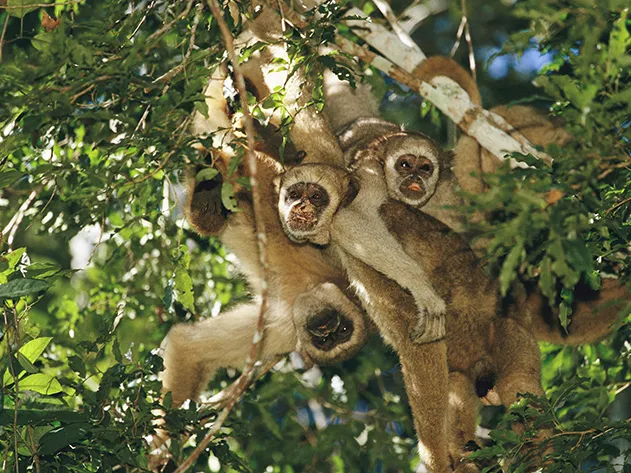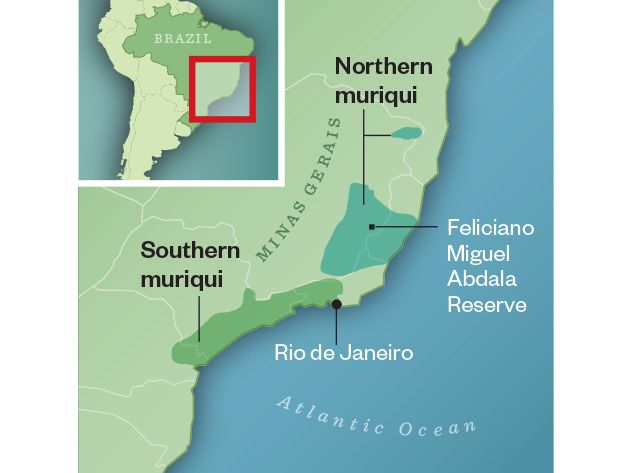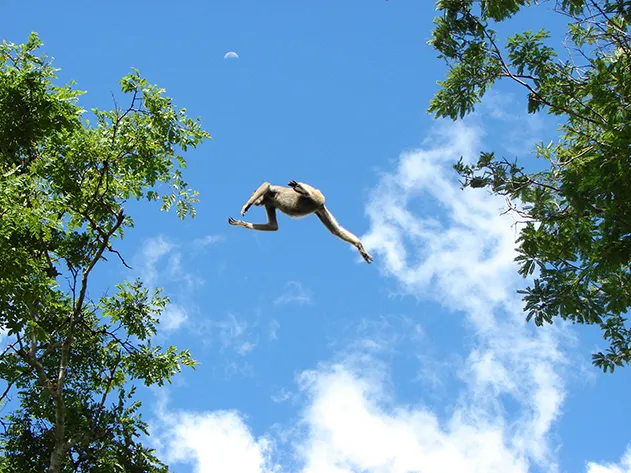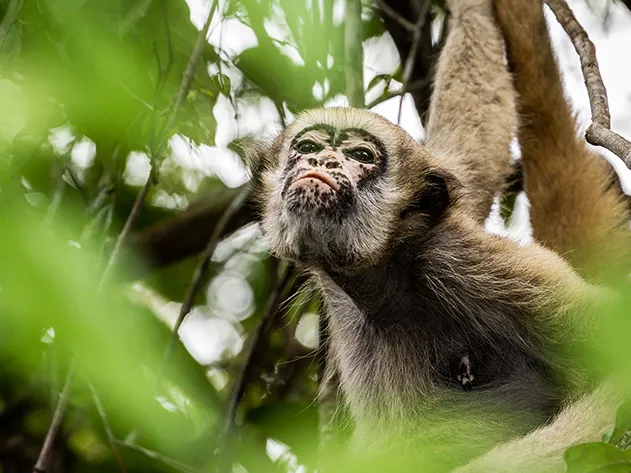Humans Would Be Better Off If They Monkeyed Around Like the Muriquis
Biologist Karen Strier has been studying these peace-loving Brazilian primates and their egalitarian lifestyle for decades
/https://tf-cmsv2-smithsonianmag-media.s3.amazonaws.com/filer/spider_monkeys_hero_631x300.jpg)
It’s 9 o’clock on a June morning in a muggy tropical forest not far from Brazil’s Atlantic coast and brown howler monkeys have been roaring for an hour. But the muriquis—the largest primates in the Americas after human beings, and the animals that the anthropologist Karen Strier and I have huffed uphill to see—are still curled high in the crooks of trees, waiting for the morning sun to warm them.
As they begin to stir, the adults scratch, stretch and watch the suddenly frisky youngsters without moving much themselves. A few languidly grab leaves for breakfast. They are striking figures, with fur that varies between gray, light brown and russet. Their black faces inspired the Brazilian nickname “charcoal monkey,” after the sooty features of charcoal makers.
Strier knows these faces well. At age 54, the University of Wisconsin-Madison professor has been observing muriquis here for three decades. One of the longest-running studies of its kind, it has upended conventional wisdom about primates and may have a surprising thing or two to say about human nature.
“Louise!” Strier says, spotting one of her old familiars. Louise belongs to Strier’s original study group of 23—clássicos, Strier’s Brazilian students call them. “She’s the only female who’s never had a baby,” says Strier. “Her friends are some of the old girls.”
Above us, two youngsters frolic near their mother. “That’s Barbara,” says Strier, “and her 3-year-old twins Bamba and Beleco.” Female muriquis typically emigrate out of their natal group at about age 6, but Barbara has never left hers, the Matão study group, named after a valley that bisects this part of the forest. Even today, more than two years after I visited Brazil, Barbara remains in the group.
Strier first came to this federally protected reserve in 1982, at the invitation of Russell Mittermeier, now president of Conservation International and chairman of the primate specialist group of the International Union for Conservation of Nature’s Species Survival Commission, who had been conducting a survey of primates in eastern Brazil. The reserve at the time held only about 50 muriquis, and Strier, a Harvard graduate student, was smitten with the lanky creatures cavorting in the canopy.
“As soon as I saw the muriquis,” says Strier, “I said, ‘This is it.’” She stayed for two months and then returned for 14 more.
In those days, to reach this patch of forest she rode a bus almost 40 miles from the nearest town and walked the last mile to a simple house without electricity. Often alone, she rose before dawn to look for the monkeys and didn’t leave the forest until they had settled down at dusk. She cut her own network of footpaths, collecting data on births, relationships, diets, dispositions, daily locations and emigrations. At night, she sorted the data by the light of gas lanterns.
“As my contact with the animals increased, they introduced me to new species of food that they ate, and allowed me to witness new behaviors,” Strier wrote in her 1992 book Faces in the Forest, now a classic of primatology. As a personal account of a field biologist’s extraordinary, often lonely efforts to become acquainted with a wild primate, Strier’s work has been compared to Jane Goodall’s In the Shadow of Man and Dian Fossey’s Gorillas in the Mist.
When Strier was first getting to know the muriquis, primatology was still largely focused on just a handful of species that had adapted to life on the ground, including baboons, or that had close evolutionary relationships with humans, such as apes. This emphasis came to shape public perception of primates as essentially aggressive. We picture chest-beating, teeth-flashing dominant male gorillas competing to mate with any female they choose. We picture, as Goodall had witnessed beginning in 1974, chimpanzees invading other territories, biting and beating other chimps to death. Primates, including possibly the most violent one of all—us—seemed to be born ruffians.
In reality, as Strier’s work would underscore, the primates are a varied group, with diverse social structures and far more complex behavior. Descended from a tree-dwelling ancestor living some 55 million years ago in Africa or Asia, the group includes tarsiers, lemurs, lorises, monkeys, apes (such as gorillas, chimps, bonobos, gibbons) and hominids. Monkeys, characterized by long tails and flat, hairless faces, are generally divided into two types: Old World monkeys, such as baboons and macaques, live in Asia and Africa. New World monkeys, including muriquis, are descended from ancestors that found their way from Africa to South America perhaps 35 million years ago.
For a long time, New World monkeys were the second-class citizens of primatology. “New World primates were considered not so smart, not so interesting, and not so relevant to human evolution,” says Frans de Waal, director of the Living Links Center at Emory University’s Yerkes National Primate Research Center. “They were sidelined—totally inappropriately, as Karen has demonstrated.”
Strier’s research introduced the world to an alternative primate lifestyle. Female muriquis mate with a lot of males and males don’t often fight. Though bonobos, known for their casual sex, are often called the “hippie” primates, the muriquis in Strier’s study site are equally deserving of that reputation. They are peace-loving and tolerant. Strier also showed that the muriquis turn out to be incredibly cooperative, a characteristic that may be just as important in primate societies as vicious rivalry.
Strier’s ideas shook up primatology, making her an influential figure in the field. Her widely used textbook, Primate Behavioral Ecology, is in its fourth edition and “has no peers,” according to the American Society of Primatologists. In 2005, at age 45, Strier was elected to the National Academy of Sciences, a rare honor. The University of Wisconsin recently recognized her with an endowed professorship. The money is being used to support her research in Brazil, where the muriquis she knows so well continue to surprise her.
Lately, they’ve been doing something arboreal primates aren’t supposed to do. In an unusual behavioral twist, they’re coming down out of the trees.
***
Muriquis are acrobats, spending much of the day swinging through the treetops in search of food. They ride branches down and scurry across vines like tightrope walkers. Hanging fully extended, muriquis appear five feet tall but weigh only 20 pounds, an elongated physique allowing for quick and astonishingly nimble movement.
As Strier and I walk through the forest, the muriquis sound like a herd of horses flying overhead. They neigh to maintain long-distance contact. A staccato hnk hnk hnk keeps them out of one another’s way, and an excited chirp summons the others when a monkey has found a fruiting tree.
Muriquis’ cooperative behaviors are often on display when they’re eating. A few days into my visit, Strier and I watch nine males demonstrate their manners as they eat pods in a legume tree. When one monkey scoots past another on a branch, it pauses to hug its neighbor, as if to say, “Pardon, so sorry.”
Muriquis almost never fight over food with members of their own group. They will chase howler monkeys or capuchins out of fruiting trees, and they loudly protest incursions by muriquis from other parts of the forest. But males and females, young and old, behave toward members of their own group in ways that can fairly be described as considerate.
Some of the muriquis in the legume tree exchange little pats as they brush by each other. Two of them, on a short break from eating, sit haunch to haunch, one resting his hand on top of the other’s head. Before they resume picking pods, they hug.
Affectionate gestures, including full-body face-to-face embraces, are common. It’s not unusual to see five or more muriquis in a tangled furry cuddle. Strier says that some males become more popular as they age, and younger males seek the company of the elders and solicit hugs during times of tension. Squabbles are rare. “Maybe their drive for social cohesion and conformity is much stronger than their aggression,” says Strier.
They also tend to be easygoing about the other big activity that agitates almost all other primates: sex. Unlike chimpanzees and baboons, male muriquis don’t attack rivals to keep them from females, Strier says. There are no alphas in these societies, so muriqui twosomes don’t have to sneak off to evade punishment by jealous suitors. What’s more, female muriquis don’t need to form coalitions to protect infants from murderous males. Strier has called muriqui mating a “passive affair.” Males don’t chase down females or bully them into sexual submission. Instead, a male waits for an invitation from a female, who selects her partners and copulates openly. Instead of battling each other for access to females, males bond into extensive brotherhoods, and Strier suspects they have replaced fighting with “sperm competition.” In proportion to their slight frames, muriquis have oversized testicles. It may be that the male producing the most sperm has the most tickets in the reproductive raffle.
When Strier first observed these behaviors, she thought muriquis were anomalies in the primate world. But as research documented the behaviors of a broader range of primates, Strier realized there was actually a lot of variation—more than was generally acknowledged. In 1994 she wrote a paper titled “Myth of the Typical Primate” that urged her colleagues to reconsider the emphasis on aggression as a mediator of primate relationships, which “prevailed despite repeated efforts to demonstrate the limitations of such arguments.” She contended that the roots of primate social behavior, including that of people, might be more accurately reflected in the flexibility, tolerance, cooperation and affection that predominate among most primates, and that these qualities are at least as recognizably human as aggressiveness, competition and selfishness. Strier’s paper was pivotal in initiating a new way of thinking about primate behavior.
“We have this idea that competition is good,” says Robert Sussman, professor of anthropology at Washington University in St. Louis and co-author of Man the Hunted: Primates, Predators, and Human Evolution, “that everybody is out for themselves, and that the people at the top are by nature superior. But there’s now lots of evidence that competition among primates only occurs when the environment changes because of outside influence. The ultimate goal of evolution is to reach an ecological equilibrium and avoid competition and aggression, a very different point of view. Karen Strier has become one of the leaders in this alternative paradigm about the evolution of cooperation.”
So as not to influence the behavior of the muriquis themselves, Strier decided at the start only to observe them and not interact with them. She has never trapped or tranquilized a monkey to take a blood sample or to affix a radio collar, and she won’t use feeding stations to lure them to convenient spots for observations, as some researchers studying chimps in the wild have been known to do. For years she has collected hormone data on individual females by positioning herself to catch falling feces. She says they smell like cinnamon.
Though Strier maintains a kind of clinical detachment from the muriquis in the field, that doesn’t mean she’s uninvolved. She has in fact become their impassioned advocate. No matter how cooperative they are, they can’t by themselves overcome the forces at work to destroy them.
***
Once called woolly spider monkeys, muriquis occur in two closely related species that scientists didn’t officially split until 2000: northern (Brachyteles hypoxanthus) and southern (Brachyteles arachnoides). Both species live only in Brazil, in scattered remnants of the once-vast Atlantic coastal forest, now greatly reduced by clearing for pasture and agricultural land. Because of extensive habitat fragmentation, both muriqui species are classified as endangered, the northern one critically: Only 1,000 of them survive, spread across about a dozen patches of forest, one of which is Strier’s study site. Early in Strier’s career, colleagues asked her why she wanted to study monkey behavior in such an altered habitat. But Strier didn’t see the environment as an obstacle; she wanted to know how the monkeys adapt.
Born in New Jersey, Strier grew up in southern California, western New York and then Maryland. She enjoyed the outdoors, hiking and backpacking with friends, but she doesn’t trace her deep fascination with primates to any childhood “aha” moment, unlike Jane Goodall, who recalls receiving a toy chimpanzee as a youngster. As an undergraduate studying biology and anthropology at Swarthmore College, Strier actually thought she might go on to conduct research on bears in the United States. But during her junior year she was offered the opportunity to work on the Amboseli Baboon Project in Kenya. She had never taken a course in primatology.
“It was a catharsis,” she says. “Everything about who I was and what I liked came together—the outdoors, the animals, science.” It was in graduate school that her adviser connected her with Mittermeier, who connected her with the muriquis. “She’s one of the great leaders in primatology today,” says Mittermeier. “She’s had a huge influence in Brazil. She has trained some of the key people there, the richest country on earth for primates.”
Her research is situated in the 2,365-acre federally protected Reserva Particular do Patrimônio Natural Feliciano Miguel Abdala, named after the coffee farmer who owned the land. After Abdala’s death in 2000, his heirs followed his wishes and put the forest into permanent trust as a reserve. More than four dozen Brazilian students have conducted research there under Strier, with pairs and trios rotating in and out every 14 months. Strier typically spends about a month each year at the reserve, conversing with the students and making quips in Portuguese, which she studied for one semester but largely picked up during her fieldwork. She spends the rest of her time in Madison, where she lives with her husband and their cats. She prefers dogs, but her travel schedule makes caring for them difficult.
Acting on her profound concern for the muriquis’ future, she has discussed in public lectures and scientific papers the need for national and international investment in wildlife preservation and for educational programs and employment opportunities that get the local community involved. She is a key member of the committee that advises the Brazilian government on its plans for muriqui conservation. Largely thanks to her efforts, the muriquis have become something of a cause célèbre of conservation in Brazil, featured on T-shirts and postage stamps. In June, the city of Caratinga, Brazil, not far from the reserve, made Strier an honorary citizen, and used her project’s 30th anniversary to announce a new long-term sustainability program.
Though northern muriquis are critically endangered, the population in Strier’s study site, which is protected from further deforestation and hunting, has increased. There are now 335 individuals in four groups, a sixfold increase since Strier started her study.
That’s a development worth celebrating, but it’s not without consequences. The monkeys appear to be outgrowing the reserve and, in response to this population pressure, altering millennia of arboreal behavior. These tree-dwellers, these born aerialists, are spending more and more time on the ground. At first the behavior was surprising. Over time, though, Strier made some sense of it. “They’re on an island, with no place to go but up or down. When humans didn’t have enough food, they invented intensive agriculture. Monkeys come to the ground. It makes me think of how hominids had to eke out an existence in a hostile environment. Our ancestors would have brought to that challenge the plasticity we’re seeing here.”
Initially the muriquis descended only briefly and only for necessities, Strier says. Now they’re staying down for up to four hours—playing, resting and even mating. One of Strier’s students shot a video of a big group of monkeys lounging on the ground, leaning against each other and casually hugging, as if they’re at a picnic. “Next they’ll lose their tails,” jokes Carla Possamai, a Brazilian postdoctoral researcher who’s been working with Strier at the reserve for a decade.
One day we watch muriquis eat white berries on low bushes. At first the monkeys hang from their tails above the bushes, but soon they drop to the ground and stand there like customers at a pick-your-own patch. Upright but awkward, they are out of their element. “You’re watching an animal whose body is adapted for something else, using it in new ways,” says Strier.
In another unexpected break with predictable behavior, five female muriquis emigrated to another forest on the far side of 200 yards of bare pasture. Two of these adventurers made the dangerous trip back into the reserve, where it’s suspected that one of them mated before again crossing the open ground to the new forest.
Eking out a living on the ground might sound like a radical departure with no real consequences, but it makes the muriquis more vulnerable to predators. Camera traps have captured images of ocelots and a family of cougars in the reserve, and feral dogs and other carnivores are known to roam the pastures.
“Basically they’re telling us they need more space,” Strier says. To give it to them, Preserve Muriqui, the Abdala family foundation that runs the reserve, is working with local ranchers and landowners to connect the forest to the archipelago of small forest fragments on the reserve’s periphery.
Strier wonders about the potential for other changes. What will peaceful, egalitarian primates do if crowding becomes more severe and resources run short? “I predict a cascade of effects and demographic changes,” she says. Will the monkeys become more aggressive and start to compete for food and other essentials the way chimps and baboons do? Will the clubby camaraderie between males fall apart? Will the social fabric tear, or will the muriquis find new ways to preserve it? Strier has learned that there is no fixed behavior; instead, it’s driven by circumstances and environmental conditions. Context matters.
“Nature is designing my experiment: the effects of population growth on wild primates,” she says. Among the many unknowns there’s one certainty: The muriquis will try to adapt. “It’s not surprising that long-lived, intelligent, socially complex primates are capable of great behavioral plasticity,” says Strier. "It gives me hope. After watching this group for 30 years," she adds, "anything is possible."
/https://tf-cmsv2-smithsonianmag-media.s3.amazonaws.com/accounts/headshot/Kemper_HighRes_2.png)





/https://tf-cmsv2-smithsonianmag-media.s3.amazonaws.com/accounts/headshot/Kemper_HighRes_2.png)